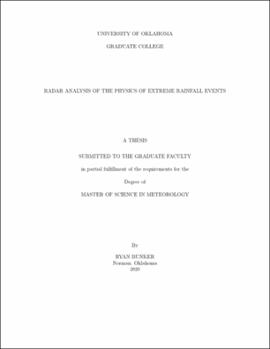| dc.description.abstract | Extreme precipitation events pose a threat to life, property, and economic growth throughout the United States and across the world. Although extensive research has focused on improving understanding of extreme precipitation at short space and time scales, there is still much that needs to be understood on the subseasonal to seasonal (S2S) timescale. This thesis uses a database of observed S2S extreme precipitation events in the United States and high-resolution ground-based radar observations to identify the leading source of precipitation, either convective or stratiform, and how it varies based on event type (location, dynamics, season, etc.). S2S precipitation events are defined as 2-week precipitation accumulations that exceed the 95th percentile accumulation for a given location and time period, along with exceedance of percentile thresholds and spatial extent criteria. A 3-D radar echo classification algorithm was used to objectively stratify precipitation into convective and stratiform components. Using these identified events, atmospheric variables from reanalysis (i.e., geopotential height, winds, 850 hPa relative humidity, 850 hPa temperature, mean sea level pressure, and precipitable water) are used to gain an understanding of the evolution of the atmospheric state during the precipitation events. Common synoptic patterns seen during these events include troughing upstream of the precipitating region, deep moisture transport into the region, and a synoptic-scale boundary in close proximity to precipitation. For example, the Northern Plains, Great Lakes, and Northeast events were all characterized as mid-latitude environments; whereas the Southern Plains had 3 mid-latitude events and 3 tropical events, and the Southeast had 4 mid-latitude events and 2 tropical events. The primary differentiation among these different environments were the upper-level forcing (or lack thereof for tropical environments) and baroclinic boundaries associated with extratropical cyclones. Seasonally, tropical environments and associated convective dominance took place in the summer to early fall across the Southern Plains and Southeast. Regions that were more poleward (i.e., Northern Plains, Great Lakes, and Northeast) were predominately stratiform dominant, except for a few events in the summer where convection was dominant. All together, these results represent a progressive step forward in helping understand S2S events and their characteristics on a regional scale. | en_US |
